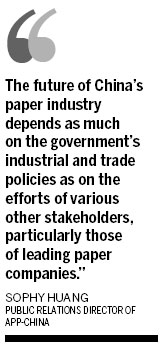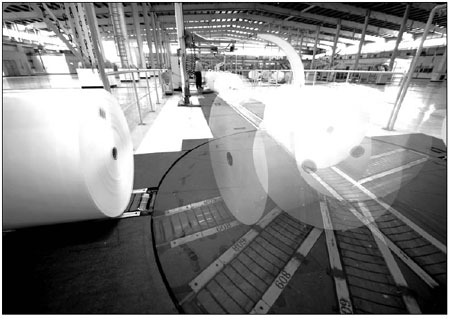Paper special: Paper industry wrapped in range of challenges
|
State-of-the-art plant of Gold East Paper in Zhenjiang, a subsidiary of APP-China and the largest single art paper mill in the world. Provided to China Daily |

Producers face duties abroad and need for sustainable transformation at home
With the recovery of the Chinese economy and surging domestic demand, the country's paper industry boomed in 2010 - the last year of the 11th Five-Year Plan (2006-10) - and is now moving into a period of strategic transformation, say industry leaders.
The industry is facing challenges both at home and abroad.
In Europe and the United States trade barriers have weakened the position of imported products.
High duties have been imposed on Chinese paper by the United States and industry insiders are not optimistic about an impending ruling from the European Union.
"I believe the investigation is more about politics than economics or business," Zhao Wei, secretary-general of the China Paper Association, said last year about the EU trade investigation.
Even the environment is a battleground, with a so-called "green wall" of indirect barriers in the developed world.
Interest groups citing environmental protection apply business pressure on products and industries from developing countries, regardless of genuine efforts that Chinese - or other Asian - companies are making to achieve a balance of social, environmental and economic priorities.
The trend is felt in the paper industry too.
"The paper industry in Asia is criticized by some environmental groups because of a lack of understanding of the complicated socio-economic issues on the ground," said Sophy Huang, public relations director of APP-China, one of Asia's leading paper companies.
"We hope that this can change with time. And it would be absolutely wrong if these issues were just a front for larger business interests," she added.
That perspective is also growing in some circles of the developed world too.
Patrick Moore, co-founder and former leader of Greenpeace, commended APP's commitment to sustainability after his team's recent intensive on-the-ground analysis of APP's Indonesian operations.
He acknowledged that "(Western) environmental organizations often tend to look at the developing world with blinders, ignoring the big picture."
In fact, leading Chinese paper companies now have plants with carbon capture and energy reduction technologies more advanced than those of their Western peers.
Internal challenges
Even so, China's paper industry is also facing complex internal challenges.
The central government has implemented a series of policies to push for further energy saving and pollution reductions.
To achieve the goal of eliminating backward production facilities, local governments are urged to join the effort - in addition to dealing with the contradiction between increasing paper demand and environmental and resource constraints.
Many industry experts believe that the true difficulty lies in years to come.
Early reports say that "structural adjustments," "value transformation" and "green development" are the keywords of the draft of 12th Five-Year Plan (2011-2015) for the industry.
The plan also sets standards for the speed of industry development, environmental protection and use of resources, and it includes new policies for industry support, which will benefit the leading players in the industry.
Industry insiders say the government's efforts in eliminating outdated production facilities are a good move in the right direction, but normal market forces would probably achieve the same results.
They note the paper industry needs to make structural adjustments to ensure sustainable development.
Transformation
Various models are proposed for the transformation, including plantation-pulp-paper integration that would help to mitigate the effects of shrinking resources. It would then be easier to craft products to specific and quickly changing market demands, and along with investment better R&D would raise product quality.
"The future of China's paper industry depends as much on the government's industrial and trade policies as on the efforts of various other stakeholders, particularly those of leading paper companies," said APP's Huang.
"For years, APP has been advocating the practice of plantation-pulp-paper integration and making efforts to improve its product quality and increase environmental performance.
"In the next five years, APP-China will continue its efforts, and hopefully more paper companies will join in and pay more attention to clean production and behave responsibly, allowing the country's objective of green development to be reached," she added.
"APP believes the concept of sustainable papermaking is quite simple - consumer demand for paper products exists and is increasing, so companies like us planting or replanting trees can ensure a green and sustainable cycle of paper supply," Huang said.
To realize long-term objectives of the paper industry in China, companies and consumers need to work together to create the future shape of sustainable papermaking and consumption. The industry cannot survive without being sustainable, and the people who know this best are those working in the paper industry.
(China Daily 03/10/2011 page14)















